City guides


Hobart Travel Guide
Tucked between Mount Wellington and the River Derwent, 12 miles (20km) upstream of the river mouth, Hobart is the capital of Tasmania, and boasts one of the world's most secure deep-water harbours. Hobart was established in 1804 and is saturated in colonial history. It is a sleepy, charming city and a great travel hub for Tasmanian adventures.
The main historical district, Battery Point, is characterised by colonial stone cottages, tearooms, antique shops, restaurants and pubs. The Narryna Van Diemen's Land Folk Museum at Battery Point depicts 19th-century pioneer life. Here one also finds the Maritime Museum of Tasmania. Like most Australian cities Hobart has plenty of green lungs: the largest is the Royal Tasmanian Botanical Gardens, which is known for English-style plantings and trees, and a Japanese garden dominated by a miniature Mount Fuji.
Other amusements for visitors include steam locomotive rides, guided tours of a former women's prison, tours of the Cascade Brewery, gaming at Australia's first legal casino at Wrest Point, taking a cruise of the harbour, or sampling the delights of the fudge factory at Island Produce Tasmania. Mount Wellington, which is a 13-mile (22km) drive from the city, offers extensive views across alpine shrubs and the city below.
Things to do in Hobart
The second oldest city in Australia, Hobart is indeed a fascinating place to visit. Dating back to 1804 when it grew out of the penal settlement on the island, Hobart boasts many beautiful historical buildings and areas, all beneath the majestic backdrop of the often snow-capped Mount Wellington.
There are many rewarding ways to spend your time in Hobart. Visitors can take a stroll along the riverfront and admire the Georgian and Victorian architecture, then visit Battery Point to see buildings made out of Hobart's golden sandstone, which gives parts of the city a warm, golden glow. On a Saturday, it's worth visiting Salamanca Place, where the sandstone warehouses date back to the 1830s and stalls line the maze of streets selling everything under the sun; the surrounding art galleries, theatres and cafes will cater to visitors' every entertainment need.
Travellers should also check out the Tasmanian Museum and Art Gallery to see the stuffed Tasmanian Devil and the extinct Tasmanian Tiger, or head to the Maritime Museum of Tasmania to learn about the whaling industry, see early Aboriginal boats and even shipwrecks. Hobart's wine industry has exploded in recent years and a day out in the Coal River Wine Region and D'Entrecasteaux Channel, sampling some of the region's wines and gourmet cuisine at Moorilla, one of Australia's most awarded vineyards, is not to be missed.
Travellers should look into buying the See Tasmania Card, which grants access to about 35 attractions across Tasmania, as well as tours and other discounts.
Hobart is small, compact and easy to explore on foot or by bicycle. There is an efficient local bus service, the Metro, for which day passes are available. Ferries run between Franklin Wharf and tourist spots around the harbour.
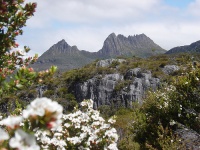
Cradle Mountain
One of Tasmania's most popular attractions is the Cradle Mountain-Lake St Clair National Park. Placed on the UNESCO World Heritage list in 1982, its landscapes include ancient rainforest and alpine heath lands, interspersed with button grass and stands of deciduous beech trees. Trails winding through forests of King Billy pines stretch around the mountain and offer superb day treks, and the 50-mile (82km) trek from Cradle Mountain in the north to Lake St Clair in the south is Australia's most famous bushwalk. The Park is equipped with mountain huts that offer accommodation for long treks, and Cradle Mountain Lodge offers log cabins in a tranquil setting. Lake St Clair, a narrow 10-mile (15km) long waterway in the south of the park, is Australia's deepest natural freshwater lake.
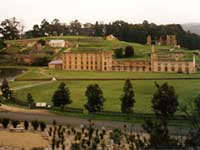
Port Arthur
Port Arthur is located in the far south of Tasmania on the Tasman Peninsula, which in the early 1800s was originally a timber station. In 1833 it became a prison settlement for male convicts, and quickly established a reputation as being 'hell on earth'. Today Port Arthur lies among 40 hectares of English Oaks and magnificent gardens as a memorial to Australia's convict past. The Port Arthur historic site offers an inclusive all day ticket, which includes a guided historical walking tour of the ruins and restored buildings, a harbour cruise and access to the visitor centre and interpretation gallery. One of the more popular features of a visit to Port Arthur is the Historic Ghost Tour run at night. Port Arthur is 65 miles (100km) southeast of Hobart. Visitors should allow about an hour and a half to enjoy the scenic drive along the Tasman and Arthur highways.
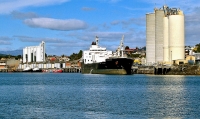
Devonport
Tasmania's third largest city, Devonport is the gateway to the island state, situated as it is in the centre of the north coast, at the mouth of the Mersey River. It is the point of arrival for car ferries from the mainland and it also welcomes visitors at its modern airport. The city is three hours by road from Hobart on the Midlands Highway. The city has a number of attractions for visitors, including aboriginal rock engravings, a maritime museum and a cycling-walking track that extends around the picturesque foreshore, past the Olympic Swimming Pool, to the historic Don River Railway, which operates vintage and steam trains. The city's central location makes it an ideal base for discovering the wilderness experiences of northwest Tasmania, especially the Mt Cradle National Park.
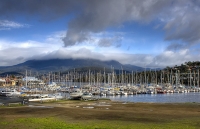
Mount Wellington
Visitors in Hobart can't help but notice that the city's skyline is dominated by the majestic Mount Wellington, which towers over the city at 4,170 feet (1,271m). Travellers can enjoy the incredible panoramic views from atop the mountain by taking a bus to Fern Tree and walking a steep zig-zag track to the top. It is frequently snow-capped, even during the summer months from time to time, and the lower slopes are thickly forested. Those who choose to rent a car can even enjoy a scenic drive to the summit. Mountain biking is also a popular sport in Wellington Park, so enthusiasts can look into hiring a bike and some gear to enjoy the wonderful single trails on offer.
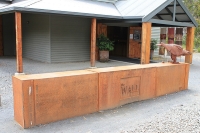
The Wall in the Wilderness
'Something special is taking place in the heart of Tasmania, and you are invited to witness its creation'. These are the words that greet visitors on the official website of The Wall in the Wilderness, and by all accounts, the sense of excitement they communicate is well earned. An ambitious project, Australian sculptor Greg Duncan aims to create a massive frieze, carved from gorgeous Huon Pine, depicting the best and worst of Tasmania's history from pre-colonial times, to trailblazing European foresters, to the extinction of the Tasmanian tiger, and the advent of hydro-electric power in the region.
The sheer scale of the undertaking is mind-blowing; Duncan aims to use 50 panels, each one metre long and three metres high, carved front and back, giving a grand total of 300 square metres of realistic engravings. Duncan says he hopes that viewing the Wall will be 'an educational as well as an artistic experience', an important reminder of both the successes and mistakes that characterise Australia's history as a nation. The work is ongoing but the carvings are already very extensive.
Eating Out
The climate, fertile soils and unpolluted waters of Tasmania ensure that the island cultivates some wonderful fresh produce, including plenty of fruit (it's not called the 'Apple Isle' for nothing) and vegetables, but also exciting things such as honey, black truffles, saffron, wasabi, olive oil and cheese. The fresh seafood is also superb, especially the Atlantic Salmon, which is farmed in Tasmanian waters. Of course, Tasmania is also celebrated for its wine, producing cool climate wines such as sparkling wine, Pinot Noir, Riesling, Chardonnay, Sauvignon Blanc and so forth. Some of the vineyards are just beyond Hobart.
For a long while Tasmania's culinary character was more British than anything else, with firmly colonial staples, but in recent years the island has embraced the Modern Australian (Mod Oz) trend and has quickly established itself as a wonderful foodie destination.
Those wanting to try their hand at Tasmanian cuisine should book a cooking class at Rodney Dunn's The Agrarian Kitchen, but such is the popularity of the school that it may be necessary to book a few months in advance.
Hobart Climate and Weather
Hobart enjoys a mild and temperate oceanic climate with four distinct seasons. The city is not hot or sunny by Australian standards, receiving an average of just under six hours of sunshine per day. Snow is not common during the winter months, but it is normal to see adjacent Mount Wellington with a snowcap. In winter, between June and August, temperatures average between 40°F (4°C) and 55° (13°C); and in summer, between December and February, temperatures average between 51°F (10°C) and 71°F (21°C). Rainfall is fairly evenly distributed throughout the year, with about 10 to 15 rainy days every month. The peak summer months of January and February are the warmest and driest months and the best time to visit.
Australia travel info
Electricity
Electrical current is 230 volts, 50Hz. Three-pin flat blade plugs are used but are different to those in most other countries, so an adapter is normally required.
Language
English is the official language of Australia.
Money
The unit of currency is the Australian dollar (AUD), which is divided into 100 cents. Credit cards are widely accepted and ATMs are freely available throughout the country. Banks and bureaux de change exchange most foreign currencies. Banking hours are generally 9.30am to 4pm, Monday to Thursday, and 9.30am to 5pm on Friday, but some banks offer extended hours and some are open on Saturday mornings.
Tipping
Most service providers in Sydney don't expect a tip, so travellers shouldn't feel pressured into giving one. A tip of 10 percent is standard in restaurants, however, and passengers usually round up to the nearest dollar or more in taxis.
Health
A yellow fever vaccination certificate is required by travellers over one year of age arriving within six days of having stayed overnight or longer in an infected country. No other special immunisations or medications are required for most trips to Australia; however, insect repellents are strongly advised because of the risk of mosquito-borne illnesses. Another health risk is sunburn, and visitors are advised to take precautions. Medical services are excellent but can be expensive, so travellers should ensure that they have adequate insurance. Australia has a reciprocal health agreement with the United Kingdom providing for free hospital emergency medical treatment; proof of UK residence is required.
Safety
The crime rate in Australia is low; however, travellers should be aware that tourists could be targeted by petty criminals. Visitors should be vigilant about personal possessions and travel documents, particularly in popular tourist destinations such as along the Gold Coast. Tropical cyclones normally occur between November and April in some parts of Australia, particularly in Western Australia, Queensland and the Northern Territory. There is a serious risk of bush fires in summer (November to March), especially in Victoria, Tasmania, New South Wales and ACT. Also during the summer months, the shallow coastal waters of northern Australia and Queensland become infested with marine stingers, commonly known as box jellyfish, whose sting is highly dangerous and can be deadly. Visitors should pay attention to signs on beaches and follow the instructions of local lifeguards to avoid injury.
Local customs
Generally an informal attitude, in dress and behaviour, prevails in most social and business situations. Sport, particularly rugby and cricket, is almost a religion in Australia.
Doing business
Those doing business in Australia are sure to find that the friendly yet professional corporate atmosphere of the country will provide them with an exciting opportunity to develop their careers. The business culture of Australia is a bit of a hybrid breed, incorporating the trappings of British formality and conservatism, the egalitarian ethos of Scandinavian countries, and the dynamic, innovative approach to business that is generally thought of as American in origin - rounded out, of course, with typical Australian warmth and humour. The approach to management in Australia is consultative, pragmatic, and strictly non-hierarchical. Those in positions of relative power are accorded respect by virtue of their personal qualities, not simply because they happen to be the boss.
Business etiquette in Australia further reflects this egalitarian ethos. Business people should use titles initially, though they will almost certainly be told to dispense with them and refer to their colleagues by their first names. They should maintain eye contact when speaking to their associates, as this is regarded as a sign of forthrightness and trustworthiness, qualities that Australian business people tend to favour over showiness, self-aggrandisement or empty promises. Business meetings in Australia should be scheduled about a week in advance, and then confirmed a few days before they are due to take place.
Colleagues should be punctual, as lateness can be seen as a symptom of flakiness or indifference. Business meetings in Australia do not generally proceed from a set agenda. Rather, they are viewed as open forums, in which ideas are to be debated and discussed. In fact, over-preparing for a meeting can make participants seem pushy, as though they wish to bully others into adopting their opinions on the issue at hand. The dress code for business in Australia remains surprisingly traditional: dark suits and ties are the norm for men; for women, business suits, worn either with pants or a skirt. As a general rule, business people should avoid loud jewellery and accessories, as to Australian eyes they might make them seem arrogant. The official language of business in Australia is English, and business hours are generally from 8.30am (or 9am) to 5pm (or 5.30pm), Monday to Friday.
Duty free
Travellers to Australia over 18 years do not have to pay customs duty on 2.25 litres of alcohol; and 25 cigarettes or 25g of cigars or tobacco products. All tobacco products in travellers' baggage are included in this category, regardless of where they were purchased. Gifts are included in the A$900 duty-free allowance. Fresh produce and animal or plant products are prohibited.
Communications
The international dialling code for Australia is +61. Hotels, cafes and restaurants offering free WiFi are widely available; purchasing a local prepaid SIM card can be a cheaper option than paying international roaming costs, which can be quite high.
Passport & Visa
A valid passport and a visa or ETA is required for travel to Australia. An ETA is an electronically issued and verified visa, not visible in a passport. ETAs are issued to passengers travelling for touristic or business purposes. Tourist ETAs are usually valid for three months. ETAs are obtainable online at: www.eta.immi.gov.au or through most travel agents. It is highly recommended that passports are valid six months after departure from a holiday destination.
Entry requirements
US nationals must have a valid passport on arrival. A pre-obtained Electronic Travel Authority (ETA) is required for stays of up to three months.
UK nationals must have a passport valid for intended period of stay. A pre-arranged Electronic Travel Authority (ETA) is required for stays of up to three months.
Canadian nationals require a passport valid for intended period of stay. A pre-arranged Electronic Travel Authority (ETA) is required for stays of up to three months.
South African nationals must have a passport valid for at least six months after their date of departure. A visa is required.
Irish nationals must have a passport that is valid on arrival. A pre-arranged Electronic Travel Authority (ETA) is required for stays up to three months.
New Zealanders require a valid passport on entry to Australia. A Special Category Visa (SCV) is issued on arrival after completing a passenger card.
Useful contacts
Australian Tourist Commission, Sydney: +61 (0)2 9360 1111 or www.australia.com
Emergencies: 000 (112 on cellphones)Embassies / consulates in other countries
Embassy of Australia, Washington DC, United States: +1 202 797 3000.
Australian High Commission, London, United Kingdom: +44 (0)20 7379 4334.
Australian High Commission, Ottawa, Canada: +1 613 236 0841.
Australian High Commission, Pretoria, South Africa: +27 (0)12 423 6000.
Australian Embassy, Dublin, Ireland: +353 (0)1 664 5300.
Australian High Commission, Wellington, New Zealand: +64 (0)4 473 6411.
Embassies / consulates in Australia
Embassy of the United States, Canberra: +61 (0)2 6214 5600.
British High Commission, Canberra: +61 (0)2 6270 6666.
Canadian High Commission, Canberra: +61 (0)2 6270 4000.
South African High Commission, Canberra: +61 (0)2 6272 7300.
Embassy of Ireland, Canberra: +61 (0)2 6214 0000.
New Zealand High Commission, Canberra: +61 (0)2 6270 4211.


